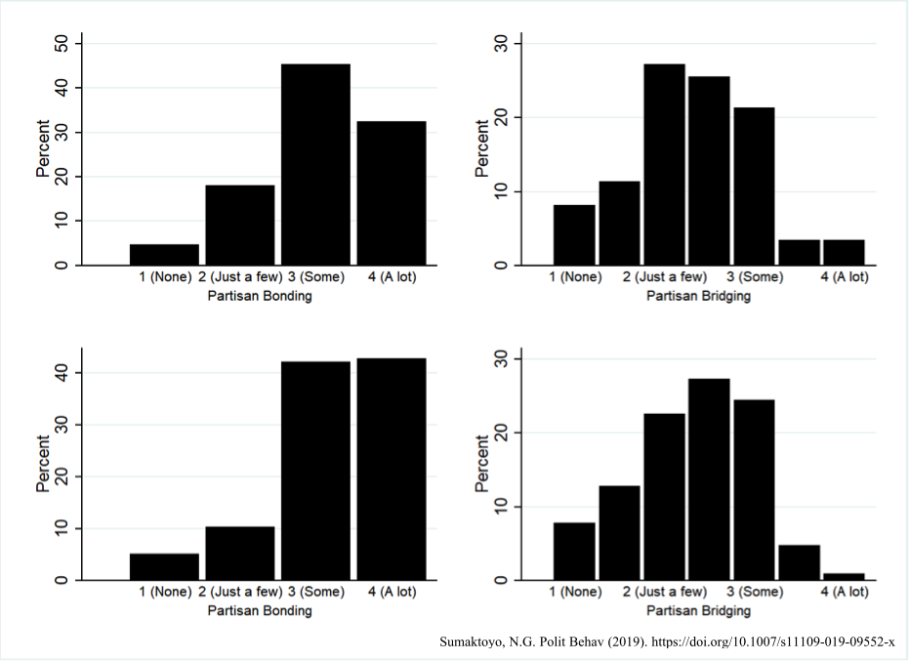Friends from Across the Aisle
This post is based on my publication in the journal Political Behavior and was also published on the journal’s blog.
Can one’s social network help one to be politically active and accepting of politically different others at the same time? This seemingly simple question has actually caused a considerable disagreement in the literature. The prevailing sentiment is that there is a trade-off between political engagement and positive outparty attitudes. One’s social network may enable one to be participatory or tolerant, but not both. My study argues that this trade-off is illusory.
To understand why this trade-off is illusory, we need to rethink our conceptualization and operationalization of partisan bonding, partisan bridging, and network disagreement. Let’s start with bonding and bridging first. Partisan bonding relates to one’s ties with politically similar others. Partisan bridging is about one’s ties with politically different others.
Existing studies mostly think of bonding and bridging as two opposites of the same continuum. If one increases (or decreases), the other has to decrease (or increase). This perfect negative relationship explains the apparent trade-off. How so?
We know from studies on contact hypothesis that bridging helps form positive attitudes toward an outgroup. If bonding and bridging were two perfect opposites, this would imply that lower bonding (higher bridging) leads to more positive outparty attitudes. On the other hand, we also know from studies on partisanship and mobilization that bonding strengthens group identity and motivates individuals to be more politically engaged. Combining these two bodies of work together, we can understand why the prevailing sentiment of a trade-off between political engagement and positive outparty attitudes might be appealing.
The problem, however, is that there is no reason why bonding and bridging have to be negatively related, or even related at all. Why can’t one have more outparty friends as she has more inparty friends?
I analyzed two original surveys of the American Public: an “American Dream” survey (N=1,550) and a “Democratic Virtues” survey (N=2,000). I asked respondents, “How many of your friends are [Democrats / Republicans / Independents]?” Partisan bonding was calculated from the friendship question that asked how many of the respondent’s friends shared her partisanship. Partisan bridging was calculated by averaging the responses to the other two questions.
Figure 1 presents the histograms of partisan bonding and bridging from both surveys. It is obvious that we do not see an inverse relationship there. In fact, I find that partisan bonding and bridging are only weakly correlated and share less than 3.5% of their variance ( for the American Dream study and for the Virtues study).
Through a series of regression models, I also find that partisan bonding and partisan bridging have different effects on political engagement and outparty attitudes. Partisan bonding is positively related to political engagement and negatively to outparty attitudes, whereas partisan bridging is positively related to both constructs.

That bonding and bridging are not perfect opposites means that we also need to rethink about how we understand network disagreement. Existing studies often equate bonding and bridging on the one hand with network disagreement on the other, or assume that the effects of bonding and bridging on outparty attitudes or political engagement depend to a large degree on how they affect network disagreement.
This assumption, I argue, is also mistaken. I contend that bonding and bridging are about social ties, whereas network disagreement is about content of interaction. Having ties with politically different others (bridging) does not necessarily mean disagreement. Disagreement only emerges to the extent that two individuals or parties in a relationship take different positions on an issue and communicate their positions. As such, partisan bonding and bridging are not the same as network disagreement and their effects on political behavior or attitudes cannot be reduced to the effects of network disagreement.
To support this claim, I ran a mediation analysis with the Democratic Virtues data (Figure 2). I find that network disagreement mediates the effects of partisan bonding more than the effects of partisan bridging. More importantly, both partisan bonding and partisan bridging still have significant direct effects on the dependent variables even after controlling for network disagreement, suggesting that the two indeed have unique explanatory powers above and beyond the effects of disagreement.



So, what do these findings mean to our understanding of social networks and political behavior? There are at least two implications. First, they mean that building outparty ties can potentially offset the negative effects of partisan bonding on how one perceives and evaluates the opposite party. This is particularly important considering concerns that scholars and observers have raised about how polarized American politics has become.
Second, they mean that we have to be more careful in conceptualizing and operationalizing bonding, bridging, and disagreement. Related to political polarization, it would be particularly interesting to understand whether polarization among the masses is accompanied or driven by higher partisan bonding, lower partisan bridging, or combination thereof.
Image Source: iStockphoto by Getty Images/Standard License
